Battle for "Electro-L"
The Electro-L spacecraft had problems with the orientation and stabilization system. Technical experts NPO them. S. A. Lavochkina is doing everything possible to accurately diagnose the fault and, if possible, eliminate it.
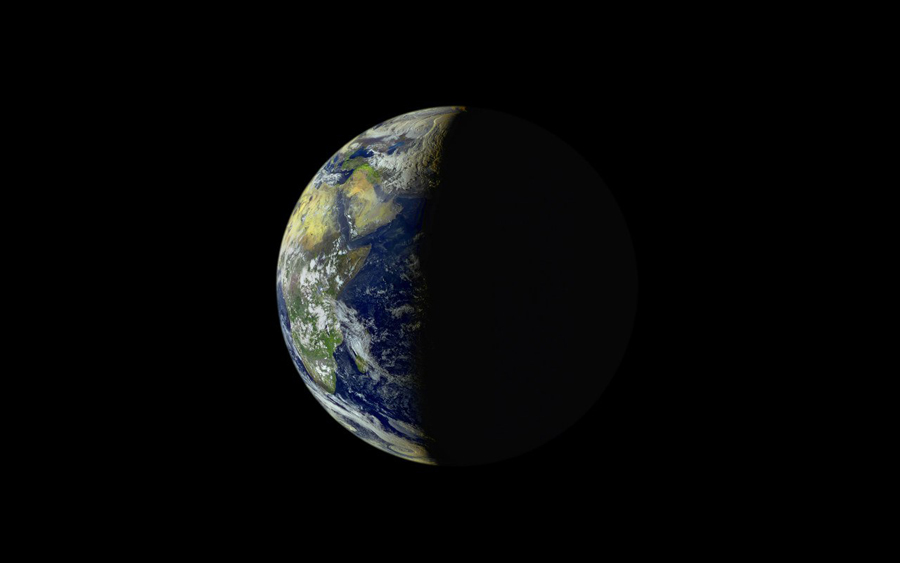
The last, at the moment, frame from the satellite. ( On the desktop )
A little more than three years "Electro-L" rotates in a geostationary orbit, at an altitude of 36 thousand km. And for more than two years in a row, every 30 minutes, he created magnificent 120-megapixel images of the visible disk of the Earth. He took the first shot in February 2011 and since then has worked in the interests of Roshydromet and Roskosmos. At the same time, delighting us with the opportunity to watch our home planet almost online.
')
“The terribleness of the car is the limit ...” (c) and on April 2, as the creator of the group “ Sputnik“ Electro-L ”Vkontakte, they wrote:“ What happened? Already six hours snapshots are not updated? “At first, I did not attach any importance to the issue. Any service work is sometimes carried out with the device, or they turn off the reception of pictures, if the sun flashes into the lens. But an hour later on the Astronautics News forum they wrote :“ The publication of pictures was suspended ... Is everything OK with the satellite? ". A little later, information appeared that there was a problem with KUDM (engine control flywheel complex).
This has already meant a serious problem. A similar situation happened half a year ago with the NASA Kepler space telescope - an exoplanet hunter. He refused two of the four reaction weels, because of what he almost ceased his activities, and, which is characteristic, also after three years of successful work. At that time, NASA actively informed about this situation, therefore, probably, many have heard about it.
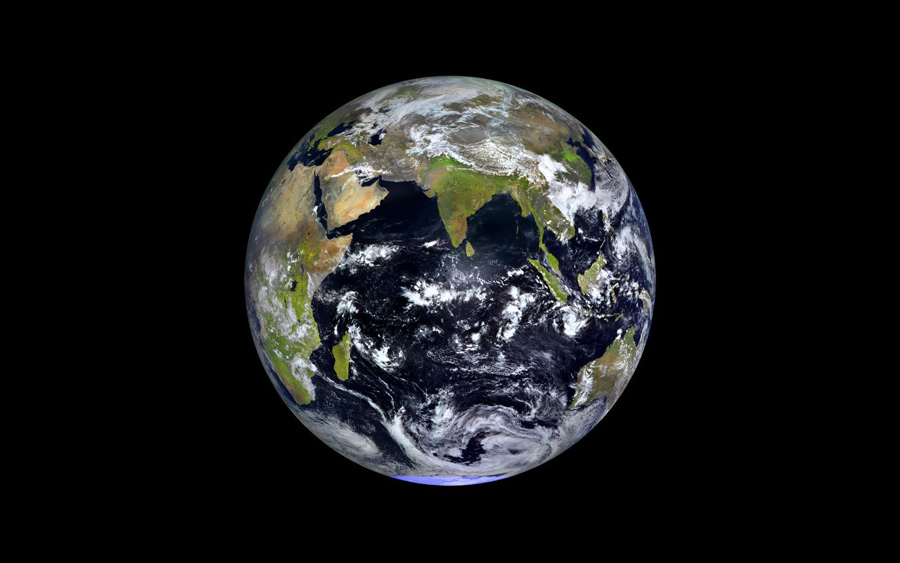
Spring Equinox 2014 with Electro-L ( On the desktop )
The principle of work of “Electro-L” is in many respects similar to Kepler, although our device does not take off the stars, but the Earth, but its stabilization and orientation tasks are almost the same - look at one point and periodically take pictures. For "aiming" spacecraft use a system of engine flywheels or gyrodynes (gyrodynes can still change the axis of rotation, but in the Electro-L they are fixed rigidly). Sometimes they are mistakenly called gyroscopes, for a similar principle of operation. In fact, both are yula. Only gyros rotate at the same speed and keep the axis of rotation - the so-called. threefold gyros.

Gyroscopes are needed to determine changes in the angles of the apparatus, i.e. in zero gravity, the satellite turns as it wants, and the gyroscope, like the arrow of a three-dimensional compass, always helps to determine where the conditional top and where the bottom is. A gyrodin (flywheel engine, reaction weels) is also a “whirligig”, only it constantly changes the rotation speed - it is spun in one direction to turn the device, hanging in weightlessness, into the opposite.
Flywheel engines, unlike gyroscopes, are often rigidly fixed in one plane, therefore, three gyrodins are required for the orientation of the spacecraft.
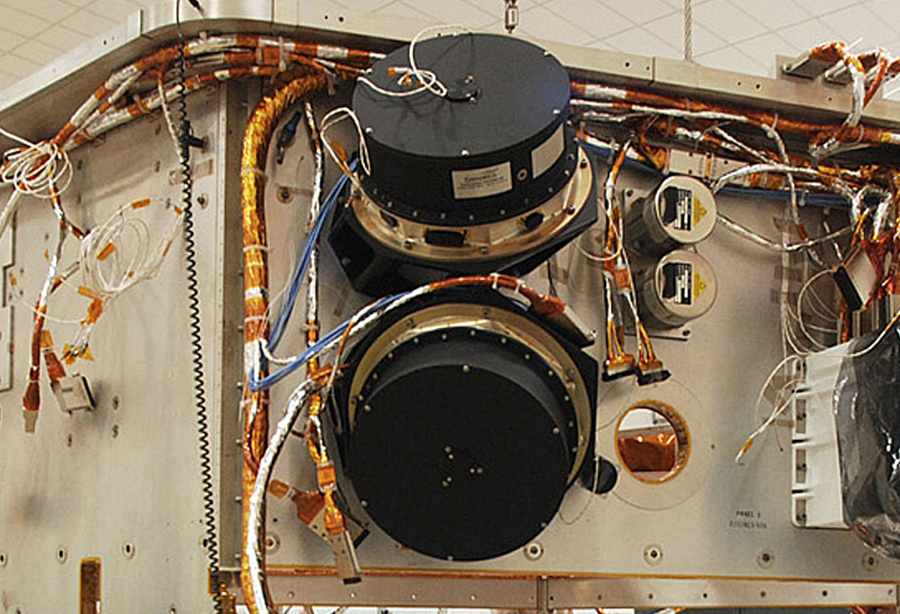
In the photo: two Kepler flywheels.
Using such a principle allows spacecraft to be stabilized with high accuracy than space telescopes, Earth remote sensing satellites, and many other spacecraft use. When the flywheel is spun up to maximum speed, it loses its functionality, therefore it is “unloaded” - it is braked, and the resulting torque is compensated by other means. On large vehicles, like the Electro-L, almost always use correction and / or orientation engines. For satellites in a near-Earth orbit, the magnetic field of the planet can be used.
Unlike the American telescope, our "Electro-L" engines themselves-flywheels in working condition.
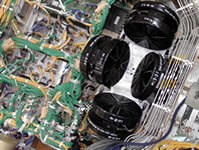
The only available photo of these instruments on board the Electro-L
Spontaneous disconnection occurs due to some kind of problem with the control system of the engine flywheels (the same KUDM). This is a separate unit that distributes commands and energy to the gyrodynes.
The first shutdown occurred March 31. The next day, all the enthusiasts who watched the satellite’s activities decided that a black screen instead of the usual photo of the Earth was such an April Fool's joke. The next day, when the pictures, even the black ones, stopped coming in, the people sounded the alarm.
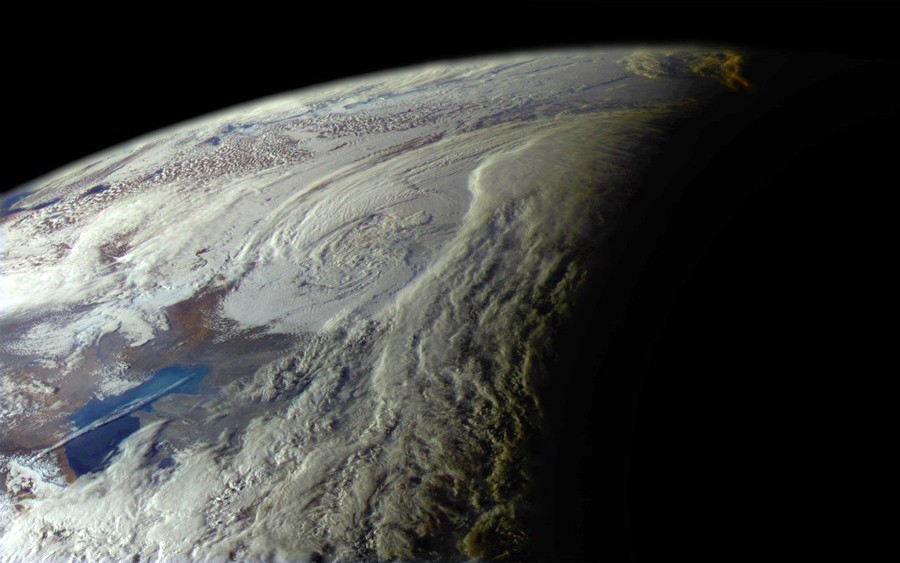
" Sunset Electro-L " ( On the desktop )
At this time, the NGO them. S. Lavochkin was intense work of all professionals involved and not involved in the work of the apparatus. In the mean telemetry numbers, they tried to find the cause of the malfunction and return the old functionality to Electro-L. It is characteristic that all the other systems worked normally: the camera was properly shooting space, the magnetometer recorded magnetic field disturbances, and heliophysical sensors showed solar activity. Repeaters receive and transmit information. Only Earth was not in the frame.

The first thing you decide to do is to click "cut". More precisely KUDM turned off for a day and gave a "rest". The shutdown allowed you to reset the probable accumulated charge of static electricity and cool the system if the cause is overheating. The satellite was stabilized using small orientation engines. They allow the device to look in the right direction, but do not provide the required accuracy for shooting the Earth in the same mode.
A day later, KUDM was launched and the results seemed very encouraging - the previous functionality was restored. But this went on for only an hour - they did not even have time to make a single picture. Then the unit turned off again.
Following the enthusiasts, journalists became interested in the satellite situation. While the engineers puzzled over the problem, responsible and irresponsible individuals began to comment on the media. Most of all, it looked like a competition for the most euphonic and positive replacement of the word “ass”.
Anatoly Goncharov, the “NTsOMZ” representative, “ calmed down ”: “ The Electro-L satellite didn’t fail, as some media sources rushed to report. There is a temporary problem, observed, by the way, from last Friday, from 17.00 Moscow time, with the transfer of satellite images, and there is nothing critical about it ... "
An unnamed representative of the NGO. S.A. Lavochkin said : "We have no information that the Electro-L spacecraft has failed, we have it. It worked and is operating normally ."
The unnamed representative of Roshydromet issued several pearls at once: “ Most likely, the device is intact, but it is not yet known which way the scanner is directed .” Then he actually admitted that they had not used the results of the satellite’s work for the previous three years: “ Meanwhile, satellite data will not affect the quality of the forecasts, since the Electro-L device is in trial operation .”
Only by the evening of April 3, a more or less intelligible and honest press release appeared on behalf of Roskosmos, which, however, they were ashamed to publish on the official website. And blogs have a more detailed technical analysis of the situation, based on the available open data.
What next? Will we see more pictures from our "Electra"?
Above the "Shop" is now hovering spirit of hope. You can go to any employee, ask in the forehead, without specifying: "Well, how?" And hear in response, "I hope it will work."
Now, probably, will try again to do "off / on". Then they will increase the rest period to several days or weeks, and they will start it again. Perhaps, they will try to reconfigure the modes of operation in order to circumvent the cause of the failure. That is what they did with the Kepler telescope. But it did not help him. There, NASA engineers decided to replace the third flywheel with sunlight pressure, and this, it seems, allowed to return the telescope's functionality by 5%.

Do we have something similar to us, and is it possible in principle, it is too early to speak, but engineers are ready to fight for their brainchild to the last.
With the failure of the engine flywheels on the "Electro-L" we lose only pictures of the Earth. Scientists will continue to receive data from the magnetometer and solar radiation sensors, Roshydromet will continue to use the satellite as a transponder, and the Emergencies Ministry will use the Cospas-Sarsat signal transmission unit. The orientation engines will be able to maintain the device in the desired position for a few more months, after which the Electro-L will be led to the burial orbit.
An additional negative effect from failure is the probability of launching the “Electro-L No. 2” launch. This satellite is almost finished, it is in the assembly shop, and is preparing to launch in 2015. If there is a similar KUDM there, then it may be subjected to additional tests or even replacement, which can significantly delay the start.

The space radio telescope Spectr-R (Radioastron), like Electro-L, was created on the Navigator satellite platform, but its systems are duplicated - it has 8 flywheel engines and two KUDM, therefore, even if half fail , the rest will be able to maintain work as before.
We can only hope that "Electro-L" will work.
Another read about the satellite: "Beautiful science from Electro-L"
"On the cosmic kindness and the Chelyabinsk meteorite . "
There is even more.

The last, at the moment, frame from the satellite. ( On the desktop )
A little more than three years "Electro-L" rotates in a geostationary orbit, at an altitude of 36 thousand km. And for more than two years in a row, every 30 minutes, he created magnificent 120-megapixel images of the visible disk of the Earth. He took the first shot in February 2011 and since then has worked in the interests of Roshydromet and Roskosmos. At the same time, delighting us with the opportunity to watch our home planet almost online.
')
“The terribleness of the car is the limit ...” (c) and on April 2, as the creator of the group “ Sputnik“ Electro-L ”Vkontakte, they wrote:“ What happened? Already six hours snapshots are not updated? “At first, I did not attach any importance to the issue. Any service work is sometimes carried out with the device, or they turn off the reception of pictures, if the sun flashes into the lens. But an hour later on the Astronautics News forum they wrote :“ The publication of pictures was suspended ... Is everything OK with the satellite? ". A little later, information appeared that there was a problem with KUDM (engine control flywheel complex).
This has already meant a serious problem. A similar situation happened half a year ago with the NASA Kepler space telescope - an exoplanet hunter. He refused two of the four reaction weels, because of what he almost ceased his activities, and, which is characteristic, also after three years of successful work. At that time, NASA actively informed about this situation, therefore, probably, many have heard about it.

Spring Equinox 2014 with Electro-L ( On the desktop )
The principle of work of “Electro-L” is in many respects similar to Kepler, although our device does not take off the stars, but the Earth, but its stabilization and orientation tasks are almost the same - look at one point and periodically take pictures. For "aiming" spacecraft use a system of engine flywheels or gyrodynes (gyrodynes can still change the axis of rotation, but in the Electro-L they are fixed rigidly). Sometimes they are mistakenly called gyroscopes, for a similar principle of operation. In fact, both are yula. Only gyros rotate at the same speed and keep the axis of rotation - the so-called. threefold gyros.

Gyroscopes are needed to determine changes in the angles of the apparatus, i.e. in zero gravity, the satellite turns as it wants, and the gyroscope, like the arrow of a three-dimensional compass, always helps to determine where the conditional top and where the bottom is. A gyrodin (flywheel engine, reaction weels) is also a “whirligig”, only it constantly changes the rotation speed - it is spun in one direction to turn the device, hanging in weightlessness, into the opposite.
Flywheel engines, unlike gyroscopes, are often rigidly fixed in one plane, therefore, three gyrodins are required for the orientation of the spacecraft.

In the photo: two Kepler flywheels.
Using such a principle allows spacecraft to be stabilized with high accuracy than space telescopes, Earth remote sensing satellites, and many other spacecraft use. When the flywheel is spun up to maximum speed, it loses its functionality, therefore it is “unloaded” - it is braked, and the resulting torque is compensated by other means. On large vehicles, like the Electro-L, almost always use correction and / or orientation engines. For satellites in a near-Earth orbit, the magnetic field of the planet can be used.
Unlike the American telescope, our "Electro-L" engines themselves-flywheels in working condition.

The only available photo of these instruments on board the Electro-L
Spontaneous disconnection occurs due to some kind of problem with the control system of the engine flywheels (the same KUDM). This is a separate unit that distributes commands and energy to the gyrodynes.
The first shutdown occurred March 31. The next day, all the enthusiasts who watched the satellite’s activities decided that a black screen instead of the usual photo of the Earth was such an April Fool's joke. The next day, when the pictures, even the black ones, stopped coming in, the people sounded the alarm.

" Sunset Electro-L " ( On the desktop )
At this time, the NGO them. S. Lavochkin was intense work of all professionals involved and not involved in the work of the apparatus. In the mean telemetry numbers, they tried to find the cause of the malfunction and return the old functionality to Electro-L. It is characteristic that all the other systems worked normally: the camera was properly shooting space, the magnetometer recorded magnetic field disturbances, and heliophysical sensors showed solar activity. Repeaters receive and transmit information. Only Earth was not in the frame.

The first thing you decide to do is to click "cut". More precisely KUDM turned off for a day and gave a "rest". The shutdown allowed you to reset the probable accumulated charge of static electricity and cool the system if the cause is overheating. The satellite was stabilized using small orientation engines. They allow the device to look in the right direction, but do not provide the required accuracy for shooting the Earth in the same mode.
A day later, KUDM was launched and the results seemed very encouraging - the previous functionality was restored. But this went on for only an hour - they did not even have time to make a single picture. Then the unit turned off again.
Following the enthusiasts, journalists became interested in the satellite situation. While the engineers puzzled over the problem, responsible and irresponsible individuals began to comment on the media. Most of all, it looked like a competition for the most euphonic and positive replacement of the word “ass”.
Anatoly Goncharov, the “NTsOMZ” representative, “ calmed down ”: “ The Electro-L satellite didn’t fail, as some media sources rushed to report. There is a temporary problem, observed, by the way, from last Friday, from 17.00 Moscow time, with the transfer of satellite images, and there is nothing critical about it ... "
An unnamed representative of the NGO. S.A. Lavochkin said : "We have no information that the Electro-L spacecraft has failed, we have it. It worked and is operating normally ."
The unnamed representative of Roshydromet issued several pearls at once: “ Most likely, the device is intact, but it is not yet known which way the scanner is directed .” Then he actually admitted that they had not used the results of the satellite’s work for the previous three years: “ Meanwhile, satellite data will not affect the quality of the forecasts, since the Electro-L device is in trial operation .”
Only by the evening of April 3, a more or less intelligible and honest press release appeared on behalf of Roskosmos, which, however, they were ashamed to publish on the official website. And blogs have a more detailed technical analysis of the situation, based on the available open data.
What next? Will we see more pictures from our "Electra"?
Above the "Shop" is now hovering spirit of hope. You can go to any employee, ask in the forehead, without specifying: "Well, how?" And hear in response, "I hope it will work."
Now, probably, will try again to do "off / on". Then they will increase the rest period to several days or weeks, and they will start it again. Perhaps, they will try to reconfigure the modes of operation in order to circumvent the cause of the failure. That is what they did with the Kepler telescope. But it did not help him. There, NASA engineers decided to replace the third flywheel with sunlight pressure, and this, it seems, allowed to return the telescope's functionality by 5%.

Do we have something similar to us, and is it possible in principle, it is too early to speak, but engineers are ready to fight for their brainchild to the last.
With the failure of the engine flywheels on the "Electro-L" we lose only pictures of the Earth. Scientists will continue to receive data from the magnetometer and solar radiation sensors, Roshydromet will continue to use the satellite as a transponder, and the Emergencies Ministry will use the Cospas-Sarsat signal transmission unit. The orientation engines will be able to maintain the device in the desired position for a few more months, after which the Electro-L will be led to the burial orbit.
An additional negative effect from failure is the probability of launching the “Electro-L No. 2” launch. This satellite is almost finished, it is in the assembly shop, and is preparing to launch in 2015. If there is a similar KUDM there, then it may be subjected to additional tests or even replacement, which can significantly delay the start.

The space radio telescope Spectr-R (Radioastron), like Electro-L, was created on the Navigator satellite platform, but its systems are duplicated - it has 8 flywheel engines and two KUDM, therefore, even if half fail , the rest will be able to maintain work as before.
We can only hope that "Electro-L" will work.
Another read about the satellite: "Beautiful science from Electro-L"
"On the cosmic kindness and the Chelyabinsk meteorite . "
There is even more.
Source: https://habr.com/ru/post/218545/
All Articles